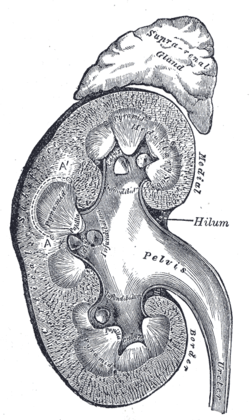- Renal pyramids
-
Renal pyramids 
1. Renal pyramid
2. Efferent artery
3. Renal artery
4. Renal vein
5. Renal hilum
6. Renal pelvis
7. Ureter
8. Minor calyx
9. Renal capsule10. Inferior renal capsule
11. Superior renal capsule
12. Afferent vein
13. Nephron
14. Minor calyx
15. Major calyx
16. Renal papilla
17. Renal column
Vertical section of kidney. Latin pyramides renales Gray's subject #253 1221 Renal pyramids (or malpighian pyramids) are cone-shaped tissues of the kidney. The renal medulla is made up of 7 to 18 of these conical subdivisions (usually 7 in humans). The broad base of each pyramid faces the renal cortex, and its apex, or papilla, points internally. The pyramids appear striped because they are formed by straight parallel segments of nephrons.
Additional images
The base of each pyramid originates at the corticomedullary border and the apex terminates in a papilla, which lies within a minor calyx, made of parallel bundles of urine collecting tubules.
See also
External links
Anatomy: urinary system (TA A08, TH H3.06, GA 11.1215) Abdomen LayersRenal fascia • Renal capsule • Renal cortex (Renal column) • Renal medulla (Renal sinus, Renal pyramids, medullary interstitium) • Renal lobe • Cortical lobule • Medullary ray • NephronRenal tubuleFiltrationPelvis Apex • Uvula • Neck • Median umbilical ligament • Muscular layer (Trigone • Detrusor) • Mucosa • SubmucosaCategories:- Kidney anatomy
- Genitourinary system stubs
Wikimedia Foundation. 2010.

